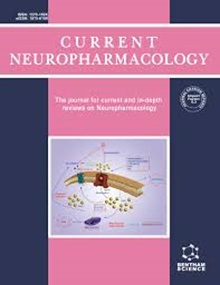利用体外、体内和微观方法评估异丁香酚的神经保护潜能
IF 4.8
2区 医学
Q1 NEUROSCIENCES
引用次数: 0
摘要
背景:阿尔茨海默病(AD)是一种影响老年人群的神经退行性疾病,与行为不稳定和认知能力下降有关。只有少数药物被批准用于阿尔茨海默病的临床治疗。挥发油及其成分具有多种药理潜力,包括神经保护特性。本研究旨在评估异丁香酚对东莨菪碱引起的认知障碍的神经保护潜力。研究方法体外抗氧化、胆碱酯酶抑制和分子对接试验均按照标准方案进行。首先使用 DPPH 和 ABTS 自由基清除试验评估了异丁香酚的抗氧化潜力。随后,根据埃尔曼试验进行了 AChE/BChE 抑制研究。为了评估化合物与酶靶位点的结合效果,我们将其与胆碱酯酶的结合位点进行了对接。使用浅水迷宫(SWM)、Y-迷宫和高架正迷宫(EPM)测试评估了补充异丁子酚对东莨菪碱诱导的健忘症的影响。结果在 DPPH 和 ABTS 试验中,异丁子酚对自由基具有相当大的功效,IC50 分别为 38.97 和 43.76 μg/mL。在 1 毫克/毫升浓度下,异丁香酚对 AChE 和 BChE 的抑制率分别为 78.39 ± 0.40% 和 67.73 ± 0.03%。在对接研究中,异丁香酚的对接得分为-12.2390,在 AChE 的活性位点残基上形成了两个氢键。此外,异丁香酚的对接得分为-10.1632,它通过两个炔氢相互作用和一个氢键与乙酰胆碱酯酶充分结合。结论:异丁香酚对东莨菪碱诱导的记忆缺陷有相当大的保护作用,并能改善啮齿动物的特殊记忆。本文章由计算机程序翻译,如有差异,请以英文原文为准。
Appraisal of the Neuroprotective Potentials of Isoeugenol Using In-vitro, In-vivo and In-silico Approaches
Background: Alzheimer's disease (AD) is a neurodegenerative condition that affects the elder population and is linked to behavioral instability and cognitive decline. Only a few drugs are approved for clinical management of AD. Volatile oils and their components exhibit diverse pharmacological potentials, including neuroprotective properties. The current study aimed to evaluate isoeugenol's neuroprotective potentials against cognitive impairments caused by scopolamine. Methods: Standard protocols were followed in the in-vitro antioxidant, cholinesterase inhibitory and molecular docking assays. Isoeugenol was initially evaluated for antioxidant potential using DPPH and ABTS free radicals scavenging assays. Subsequently, AChE/BChE inhibition studies were performed following Ellman’s assay. To assess the compound's binding effectiveness at the enzymes' target site, it was docked against the binding sites of cholinesterase. The effect of isoeugenol supplementation on scopolamine-induced amnesia was assessed using Shallow Water Maze (SWM), Y-Maze and Elevated Plus Maze (EPM) tests. Results: In DPPH and ABTS assays, isoeugenol exhibited considerable efficacy against free radicals with IC50 of 38.97 and 43.76 μg/mL, respectively. Isoeugenol revealed 78.39 ± 0.40% and 67.73 ± 0.03% inhibitions against AChE and BChE, respectively, at 1 mg/ml concentration. In docking studies, isoeugenol exhibited a docking score of -12.2390, forming two hydrogen bonds at the active site residues of AChE. Further, with a docking score of -10.1632, isoeugenol binds adequately to theBChE enzyme via two arene-hydrogen interactions and one hydrogen bond. Conclusion: Isoeugenol offered considerable protection against scopolamine-induced memory deficits and improved the special memory of the rodents.
求助全文
通过发布文献求助,成功后即可免费获取论文全文。
去求助
来源期刊

Current Neuropharmacology
医学-神经科学
CiteScore
8.70
自引率
1.90%
发文量
369
审稿时长
>12 weeks
期刊介绍:
Current Neuropharmacology aims to provide current, comprehensive/mini reviews and guest edited issues of all areas of neuropharmacology and related matters of neuroscience. The reviews cover the fields of molecular, cellular, and systems/behavioural aspects of neuropharmacology and neuroscience.
The journal serves as a comprehensive, multidisciplinary expert forum for neuropharmacologists and neuroscientists.
 求助内容:
求助内容: 应助结果提醒方式:
应助结果提醒方式:


